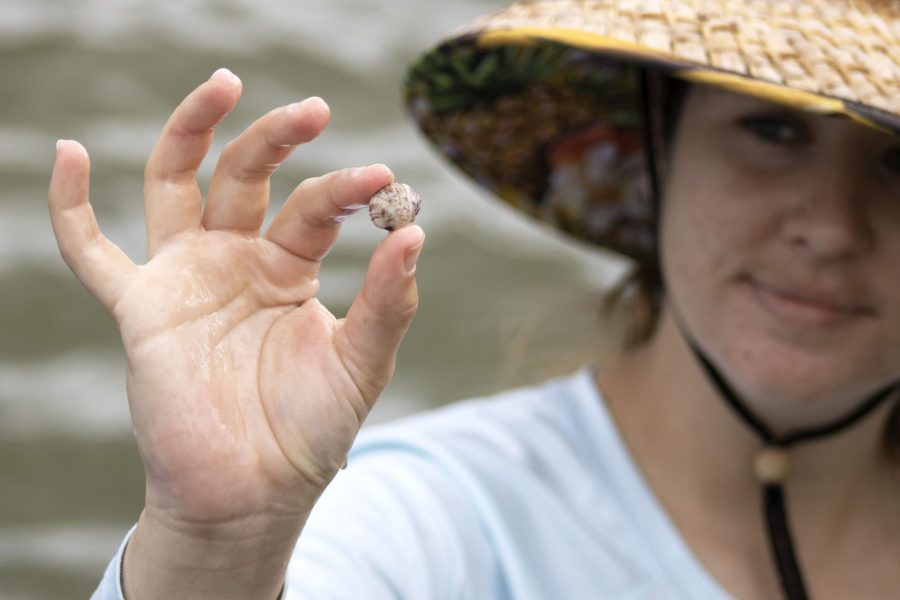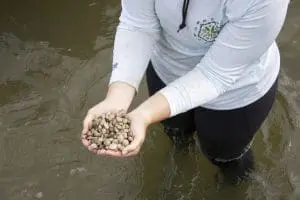

We’re taking lessons learned from our initial clam restoration project to guide the planting of future clam sites!
Nearly two years into embarking on clam restoration in the Indian River Lagoon, our Restore Our Shores (ROS) team and their partners are using the lessons learned to guide future clam planting projects!
In an effort to evaluate site suitability for hard clam restoration in the lagoon, over 8 million clams were planted throughout the three lagoon basins— Mosquito Lagoon, Banana River and the Indian River Lagoon— within Brevard, Volusia and Indian River County between April 2021 and September 2022. This project was funded through a water quality improvement grant from St. Johns River Water Management District.
Clams are filter feeders that consume algae and remove nitrogen and phosphorous from the water. These nutrients—which are found in fertilizers and human and pet waste—fuel algae blooms, muck buildup and other environmental issues ailing the lagoon like seagrass die-offs. Historically, hard clams were abundant in the lagoon during certain time periods – like in the ‘80s and ‘90s. These populations supported a large clam fishery in Brevard County in the late 20th century. Unfortunately, water quality changes and time periods in which salinity decreased led to the decrease in clams, which can now be found naturally in some inlets and further south in the lagoon.
 The University of Florida Whitney Laboratory for Marine Bioscience provided the clams used in the ROS project. The laboratory produces these clams from its “super clam” stock of native hard clams (Mercenaria, mercenaria) that have survived the harsh water quality conditions of recent decades. Homeowners and community partners volunteered their lagoon-front properties for clam restoration. Over a hundred volunteers gave their time to learn how to care for the clam beds and aided restoration work throughout the project. To “plant” the clams, Zoo staff and volunteers broadcasted the juvenile clams over sandy lagoon bottom then covered the plots with predation protection nets.
The University of Florida Whitney Laboratory for Marine Bioscience provided the clams used in the ROS project. The laboratory produces these clams from its “super clam” stock of native hard clams (Mercenaria, mercenaria) that have survived the harsh water quality conditions of recent decades. Homeowners and community partners volunteered their lagoon-front properties for clam restoration. Over a hundred volunteers gave their time to learn how to care for the clam beds and aided restoration work throughout the project. To “plant” the clams, Zoo staff and volunteers broadcasted the juvenile clams over sandy lagoon bottom then covered the plots with predation protection nets.
Our ROS team spent much of last year monitoring each of the 100 clam bed sites. They found that the salinity of the water was the strongest indicator of whether the clams survived. Our team noted that more clams survived the winter months when salinity was stable, but survivability decreased during the summer months in the northern lagoon and Banana River sites due to salinity dropping with increased rainfall. More clams survived and grew in the sites south of the Malabar area in the Central Indian River Lagoon. At some of our most successful sites, clams grew from about the size of a dime to the size of a tennis ball in just 9 months!
 We’re now working with Brevard County’s Save Our Indian River Lagoon Program to launch our clam gardening project at our 20 most successful clam bed sites in south Brevard! This month, we will plant 1 million seed size clams in nursery bags on the lagoon bottom. These clams will again be cared for by volunteers and released onto lagoon sediments once they have grown to larger sizes that reduce their vulnerability to predators.
We’re now working with Brevard County’s Save Our Indian River Lagoon Program to launch our clam gardening project at our 20 most successful clam bed sites in south Brevard! This month, we will plant 1 million seed size clams in nursery bags on the lagoon bottom. These clams will again be cared for by volunteers and released onto lagoon sediments once they have grown to larger sizes that reduce their vulnerability to predators.
Want to help? Keep an eye on Restore Our Shores volunteer projects for future opportunities!
Want to learn more? Check out the full report on our clam project.
Brevard Zoo is an independent, not-for-profit organization that receives no recurring government funding for our operating costs. Your generous support enables us to continue to serve our community and continue our vital animal wellness, education and conservation programs.